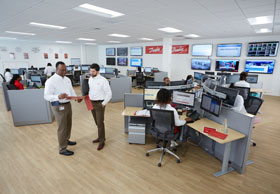

If you work in facilities or energy management for a food retailer, change is something you handle every day. When the way we live, work, or shop changes, new food retail technology is close behind.
Right now, all those things are changing like never before. Megatrends like electrification, digital communications and the fight against climate change are creating both opportunities and challenges for the food sector, worldwide.
Danfoss sees this first-hand because it works with hundreds of food retail chains in over 60 countries. The company has identified five big, overlapping changes that are combining to shape today’s supermarkets and five key ways to respond:
1. Pressure on operating margins makes cost savings essential: the average profit margin for a large food retailer currently stands at just 1,7%. In practice, this means that supermarket teams need creative ways to cut operating costs.
2. Increasing food safety and reducing food loss are more important than ever: according to the UN Food and Agriculture Organization, food wastage accounts for 3,3 Gigatons of greenhouse gas emissions. Avoiding food loss has always been essential to limit costs, now it is part of sustainability too.
3. Climate change regulation makes refrigerant choice critical: choosing an alternative with low global warming potential has growing advantages. The right refrigerant brings advantages in cost, regulation, availability, environmental impact, and sometimes tax.
4. Utilising waste heat as a resource: urban neighbourhoods will need new ways of meeting energy challenges. In some Nordic countries, retail stores divert around 30% of their excess capacity into heating homes in the surrounding area. This is a potential source of revenue.
5. Electrification is a challenge, but also an opportunity: as well as infrastructure, retailers need to find ways to prevent expensive short-term spikes in energy use. Those who can find flexibility in their energy demand may be able to cut costs.
Overlapping challenges that demand a coordinated response
These five trends influence each other. For example, the opportunity to reduce energy tariffs by optimising electricity demand is all the more compelling because of the need to find cost savings wherever possible.
In the same way, the changing food retail energy landscape needs a coordinated approach. According to Danfoss, there are five technical strategies which, when combined, will help supermarkets to stay ahead of and in some cases benefit from, society’s emerging demands.
1. Use smart refrigeration case control to reduce operating costs: too much cooling and you waste energy, too little and you risk food loss. An adaptive case controller, like the Danfoss ADAP-KOOL series, can balance refrigeration performance to the load. These advanced controllers connect to the Internet and the compressor pack controller via a system manager.
2. Connect to the Internet to eliminate food waste and cut service costs: connecting your refrigeration system to the cloud offers a host of possibilities to save money and improve food safety.
3. Treat refrigerant selection as a long-term decision: the refrigerant you choose has a significant impact on costs for the life of a store.
4. Integrate each store's systems to gain economies of scale: many retailers pay to run a heating and hot water system, while a separate refrigeration system releases heat into the atmosphere. Treating these facilities as an integrated solution can reduce a store's carbon footprint, while reducing installation and operating costs. When integrated, a store's refrigeration system can supply heat too, reducing the need for a boiler. Danfoss's purpose-built Heat Recovery Unit helps to eliminate the technical challenge.
5. Reduce energy prices by optimising demand: the fastest cost reductions are often found in managing demand patterns. Utilities companies are increasingly seeking help to match energy production to demand, discounting off-peak energy or seeking a temporary reduction in power use to manage short-term demand response events. There are several ways to achieve this, for example by using a battery bank, changing maintenance schedules, or storing energy thermally. This could include pre-cooling freezers or using an ice-making unit to load up with excess renewable energy.
It’s happening right now
Between them, these five approaches can help retailers to cut costs, minimise environmental impact and find a competitive advantage, while preserving food safety.
They’re best used in combination; for example, heat recovery is much easier with a CO2 system and smart case controllers maximise the benefit of monitoring online.
Danfoss calls this integrated approach Smart Store. Food retailers around the world are already using it to improve efficiency, find new opportunities and meet the sector’s current challenges head on.

© Technews Publishing (Pty) Ltd | All Rights Reserved